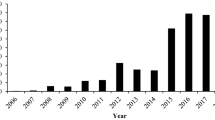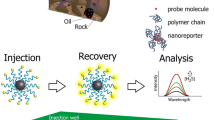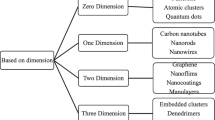Abstract
The demand for energy is inclined toward staggering heights worldwide and is proportional to the requirements of crude oil for satisfying energy needs. Globally, pollution has created a menace in each and every portion of the society we look at. Therefore, much of the today’s technology is focused on making the process much economical and sustainable, thereby lowering pressures on environment. Nanotechnology has provided options to enhance such possibilities by contributing to more economical, highly efficient and sustainable approaches with environmentally favored technologies than those conventionally available. This chapter addresses such roles of nanotechnology in different jobs played around the oil and gas industry, such as exploration industry, drilling and production, refining and processing, and in enhanced oil recovery. Besides, the different types of nanomaterials such as nanoparticles, nanoemulsions, nanosensors and nanofluids available for these applications have been discussed. Moreover, the mechanisms which reflect the activity of these nanomaterials have been explained individually. The chapter discusses how nanotechnology-based technologies can achieve more efficient, effective and potential impact in the oil and gas industry.
Access this chapter
Tax calculation will be finalised at checkout
Purchases are for personal use only
Similar content being viewed by others
References
Abidin A, Puspasari T, Nugroho W (2012) Polymers for enhanced oil recovery technology. Proc Chem 4:11–16
Ahmadi M, Habibi A, Pourafshari P, Ayatollahi S (2011) Zeta potential investigation and mathematical modeling of nanoparticles deposited on the rock surface to reduce fine migration. In: SPE middle east oil and gas show and conference, Manama, Bahrain. 142633-MS, 25–28 September 2011. Society of Petroleum Engineers
Al-Anssari S, Barifcani A, Wang S, Maxim L, Iglauer S (2016) Wettability alteration of oil-wet carbonate by silica nanofluid. J Colloid Interface Sci 461:435–442
Al-Shehri AA, Ellis ES, Servin JMF, Kosynkin DV, Kanj MY, Schmidt HK (2013) Illuminating the reservoir: magnetic nanomappers. In: SPE middle east oil and gas show and conference, Manama, Bahrain. 164461-MS, 10–13 March 2013. Society of Petroleum Engineers
Alomair OA, Matar KM, Alsaeed YH (2014) Nanofluids application for heavy oil recovery. In: SPE Asia pacific oil & gas conference and exhibition, Adelaide, Australia. 171539-MS, 14–16 October 2014. Society of Petroleum Engineers
Alvarado V, Manrique E (2010) Enhanced oil recovery: an update review. Energies 3:1529–1575
Amanullah M, Al-Tahini AM (2009) Nano-technology-its significance in smart fluid development for oil and gas field application. In: SPE Saudi Arabia section technical symposium, Al-Khobar, Saudi Arabia. 126102-MS, 9–11 May 2009. Society of Petroleum Engineers
Aveyard R, Binks BP, Clint JH (2003) Emulsions stabilised solely by colloidal particles. Adv Colloid Interface Sci 100:503–546
Ayatollahi S, Zerafat MM (2012) Nanotechnology-assisted EOR techniques: new solutions to old challenges. In: SPE international oilfield nanotechnology conference and exhibition, Noordwijk, The Netherlands. 157094-MS, 12–14 June 2012. Society of Petroleum Engineers
Bennetzen MV, Mogensen K (2014) Novel applications of nanoparticles for future enhanced oil recovery. In: International petroleum technology conference, Kuala Lampur, Malaysia. IPTC-17857-MS, 10–12 December 2014
Bera A, Belhaj H (2016) Application of nanotechnology by means of nanoparticles and nanodispersions in oil recovery—a comprehensive review. J Nat Gas Sci Eng 34:1284–1309
Binks BP, Lumsdon S (2000) Influence of particle wettability on the type and stability of surfactant-free emulsions. Langmuir 16:8622–8631
Binks BP, Rodrigues JA (2005) Inversion of emulsions stabilized solely by ionizable nanoparticles. Angew Chem Int Ed 44:441–444
Binks BP, Philip J, Rodrigues JA (2005) Inversion of silica-stabilized emulsions induced by particle concentration. Langmuir 21:3296–3302
Callaghan CA (2006) Kinetics and catalysis of the water-gas-shift reaction: a microkinetic and graph theoretic approach. Doctoral thesis, Worcester Polytechnic Institute. https://digitalcommons.wpi.edu/etd-dissertations/255
Cassidy M, Chan H, Ross B, Bhattacharya P, Marcus CM (2013) In vivo magnetic resonance imaging of hyperpolarized silicon particles. Nat Nanotechnol 8:363
Chaudhury MK (2003) Complex fluids: spread the word about nanofluids. Nature 423:131
Chengara A, Nikolov AD, Wasan DT, Trokhymchuk A, Henderson D (2004) Spreading of nanofluids driven by the structural disjoining pressure gradient. J Colloid Interface Sci 280:192–201
Cheraghian G, Tardasti S (2012) Improved oil recovery by the efficiency of nano-particle in imbibition mechanism. In: 2nd EAGE international conference KazGeo
Cheraghian G, Hendraningrat L (2016) A review on applications of nanotechnology in the enhanced oil recovery part A: effects of nanoparticles on interfacial tension. Int Nano Lett 6:129–138
Cheraghian G, Hemmati M, Masihi M, Bazgir S (2013) An experimental investigation of the enhanced oil recovery and improved performance of drilling fluids using titanium dioxide and fumed silica nanoparticles. J Nanostruct Chem 3:78
Clark PD, Hyne JB (1990) Studies on the chemical reactions of heavy oils under steam stimulation condition. Aostra J Res 29:29–39
Clark PD, Clarke RA, Hyne JB, Lesage KL (1990) Studies on the effect of metal species on oil sands undergoing steam treatments. Aostra J Res 6:53–64
Craig FF (1971) The reservoir engineering aspects of waterflooding, vol 3. HL Doherty Memorial Fund of AIME, New York. Society of Petroleum Engineers. ISBN: 978-0-89520-202-4
El-Diasty AI, Ragab AMS (2013) Applications of nanotechnology in the oil & gas industry: latest trends worldwide & future challenges in Egypt. In: North Africa technical conference and exhibition, Cairo, Egypt. 164716-MS, 15–17 April 2013. Society of Petroleum Engineers
Esmaeili A (2011) Applications of nanotechnology in oil and gas industry. In: AIP conference proceedings, vol 1. AIP, pp 133–136
Giraldo J, Benjumea P, Lopera S, Cortés FB, Ruiz MA (2013) Wettability alteration of sandstone cores by alumina-based nanofluids. Energy Fuels 27:3659–3665
Hashemi R, Nassar NN, Pereira Almao P (2013) Enhanced heavy oil recovery by in situ prepared ultradispersed multimetallic nanoparticles: a study of hot fluid flooding for Athabasca bitumen recovery. Energy Fuels 27:2194–2201
Hashemi R, Nassar NN, Almao PP (2014) Nanoparticle technology for heavy oil in-situ upgrading and recovery enhancement: opportunities and challenges. Appl Energy 133:374–387
He L, Xu J, Bin D (2016) Application of nanotechnology in petroleum exploration and development. Pet Explor Dev 43:1107–1115
Hendraningrat L, Li S, Torsater O (2013) Effect of some parameters influencing enhanced oil recovery process using silica nanoparticles: an experimental investigation. In: SPE reservoir characterization and simulation conference and exhibition, Abu Dhabi, UAE. 165955-MS, 16–18 September 2013. Society of Petroleum Engineers
Hirasaki G, Zhang DL (2004) Surface chemistry of oil recovery from fractured, oil-wet, carbonate formations. SPE J 9:151–162. 88365-PA
Hyne J (1986) Aquathermolysis: a synopsis of work on the chemical reaction between water (Steam) and heavy oil sands during simulated steam stimulation. AOSTRA Library of Information Service, Canada, OSTI ID: 220464, Reference Number: SCA: 040401
Jahagirdar SR (2008) Oil-microbe detection tool using nano optical fibers. In: SPE western regional and pacific section AAPG joint meeting, Bakersfield, California, USA. 113357-MS, 29 March–4 April 2008. Society of Petroleum Engineers
Kapusta S, Balzano L, Te Riele PM (2011) Nanotechnology applications in oil and gas exploration and production. In: International petroleum technology conference, Bangkok, Thailand, International Petroleum Technology Conference. IPTC-15152-MS, 15–17 November 2011
Karimi A, Fakhroueian Z, Bahramian A, Pour Khiabani N, Darabad JB, Azin R, Arya S (2012) Wettability alteration in carbonates using zirconium oxide nanofluids: EOR implications. Energy Fuels 26:1028–1036
Kazemzadeh Y, Eshraghi SE, Kazemi K, Sourani S, Mehrabi M, Ahmadi Y (2015) Behavior of asphaltene adsorption onto the metal oxide nanoparticle surface and its effect on heavy oil recovery. Ind Eng Chem Res 54:233–239
Ko S, Huh C (2018) Use of nanoparticles for oil production applications. J Petrol Sci Eng 172:97–114
Kong X, Ohadi M (2010) Applications of micro and nano technologies in the oil and gas industry- overview of the recent progress. In: Abu Dhabi international petroleum exhibition and conference, Abu Dhabi, UAE. 138241-MS, 1–4 November 2010. Society of Petroleum Engineers
Krishnamoorti R (2006) Extracting the benefits of nanotechnology for the oil industry. J Petrol Technol 58:24–26
Le NYT, Pham DK, Le KH, Nguyen PT (2011) Design and screening of synergistic blends of SiO2 nanoparticles and surfactants for enhanced oil recovery in high-temperature reservoirs. Adv Nat Sci: Nanosci Nanotechnol 2:035013
Le Van S, Chon BH (2016) Chemical flooding in heavy-oil reservoirs: from technical investigation to optimization using response surface methodology. Energies 9:711
Li G (2004) Properties of high-volume fly ash concrete incorporating nano-SiO2. Cem Concr Res 34:1043–1049
Li J, Meyyappan M (2011) Real time oil reservoir evaluation using nanotechnology. US Patents 7,875,455
Li S, Genys M, Wang K, Torsæter O (2015) Experimental study of wettability alteration during nanofluid enhanced oil recovery process and its effect on oil recovery. In: SPE reservoir characterisation and simulation conference and exhibition, Abu Dhabi, UAE. 175610-MS, 14–16 September 2015. Society of Petroleum Engineers
Maghzi A, Mohammadi S, Ghazanfari MH, Kharrat R, Masihi M (2012) Monitoring wettability alteration by silica nanoparticles during water flooding to heavy oils in five-spot systems: a pore-level investigation. Exp Thermal Fluid Sci 40:168–176
Li S, Hendraningrat L, Torsaeter O (2013) Improved oil recovery by hydrophilic silica nanoparticles suspension: 2 phase flow experimental studies. In: IPTC 2013: international petroleum technology conference, European Association of Geoscientists & Engineers, Beijing, China, 26–28 March 2013
Mandal A, Bera A, Ojha K, Kumar T (2012) Characterization of surfactant stabilized nanoemulsion and its use in enhanced oil recovery. In: SPE international oilfield nanotechnology conference and exhibition, Noordwijk, The Netherlands. 155406-MS, 12–14 June 2012. Society of Petroleum Engineers
Mcelfresh PM, Olguin C, Ector D (2012) The application of nanoparticle dispersions to remove paraffin and polymer filter cake damage. In: SPE international symposium and exhibition on formation damage control, Lafayette, Louisiana, USA. 151848-MS, 15–17 February 2012. Society of Petroleum Engineers
Mohammed M, Babadagli T (2015) Wettability alteration: a comprehensive review of materials/methods and testing the selected ones on heavy-oil containing oil-wet systems. Adv Colloid Interface Sci 220:54–77
Molnes SN, Torrijos IP, Strand S, Paso KG, Syverud K (2016) Sandstone injectivity and salt stability of cellulose nanocrystals (CNC) dispersions—Premises for use of CNC in enhanced oil recovery. Ind Crops Prod 93:152–160
Morrow NR (1990) Wettability and its effect on oil recovery. J Pet Technol 42(1):476–471, 484
Munshi A, Singh V, Kumar M, Singh J (2008) Effect of nanoparticle size on sessile droplet contact angle. J Appl Phys 103:084315
Nghiem LX, Coombe DA, Ali S (1998) Compositional simulation of asphaltene deposition and plugging. In: SPE annual technical conference and exhibition, New Orleans, Louisiana. 48996-MS, 27–30 September 1998. Society of Petroleum Engineers
Nikolov A, Kondiparty K, Wasan D (2010) Nanoparticle self-structuring in a nanofluid film spreading on a solid surface. Langmuir 26:7665–7670
Papadimitriou N, Romanos G, Charalambopoulou GC, Kainourgiakis M, Katsaros F, Stubos A (2007) Experimental investigation of asphaltene deposition mechanism during oil flow in core samples. J Petrol Sci Eng 57:281–293
Parvazdavani M, Masihi M, Ghazanfari MH (2014) Monitoring the influence of dispersed nano- particles on oil–water relative permeability hysteresis. J Petrol Sci Eng 124:222–231
Pina A, Mougin P, Béhar E (2006) Characterisation of asphaltenes and modelling of flocculation–state of the art. Oil Gas Sci Technol-Revue de l’IFP 61:319–343
Rahmani AR, Bryant S, Huh C, Athey A, Ahmadian M, Chen J, Wilt M (2015) Crosswell magnetic sensing of superparamagnetic nanoparticles for subsurface applications. SPE J 20(1):067–061, 082
Ravera F, Santini E, Loglio G, Ferrari M, Liggieri L (2006) Effect of nanoparticles on the interfacial properties of liquid/liquid and liquid/air surface layers. J Phys Chem B 110:19543–19551
Rellegadla S, Prajapat G, Agrawal A (2017) Polymers for enhanced oil recovery: fundamentals and selection criteria. Appl Microbiol Biotechnol 101:4387–4402
Rellegadla S, Bairwa HK, Kumari MR, Prajapat G, Nimesh S, Pareek N, Jain S, Agrawal A (2018) An effective approach for enhanced oil recovery using nickel nanoparticles assisted polymer flooding. Energy Fuels 32:11212–11221
Resasco DE, Drexler S, Harwell JH, Shiau BJ, Kadhum MJ, Faria J, Ruiz MP (2015) Method and foam composition for recovering hydrocarbons from a subterranean reservoir. US Patent Application 14/344,241, June 2015
Roustaei A, Bagherzadeh H (2015) Experimental investigation of SiO2 nanoparticles on enhanced oil recovery of carbonate reservoirs. J Pet Explor Prod Technol 5:27–33
Salem Ragab AM, Hannora AE (2015) A comparative investigation of nano particle effects for improved oil recovery—experimental work. In: SPE Kuwait oil and gas show and conference, Mishref, Kuwait. 175395-MS, 11–14 October 2015. Society of Petroleum Engineers
Schembre JM, Tang G-Q, Kovscek AR (2006) Interrelationship of temperature and wettability on the relative permeability of heavy oil in diatomaceous rocks (includes associated discussion and reply). SPE Reserv Eval Eng 9:239–250
Schröder L, Lowery TJ, Hilty C, Wemmer DE, Pines A (2006) Molecular imaging using a targeted magnetic resonance hyperpolarized biosensor. Science 314:446–449
Shah RD (2009) Application of nanoparticle saturated injectant gases for EOR of heavy oils. In: SPE annual technical conference and exhibition, New Orleans, Louisiana. /29539-STU, 4–7 October 2009. Society of Petroleum Engineers
Sharma G, Mohanty K (2013) Wettability alteration in high-temperature and high-salinity carbonate reservoirs. SPE J 18:646–655
Sheng JJ (2013) Surfactant enhanced oil recovery in carbonate reservoirs. In: Enhanced oil recovery field case studies. Elsevier, Amsterdam, pp 281–299
Shokrlu YH, Babadagli T (2011) Transportation and interaction of nano and micro size metal particles injected to improve thermal recovery of heavy-oil. In: SPE annual technical conference and exhibition, Denver, Colorado, USA. 146661-MS, 30 October–2 November 2011. Society of Petroleum Engineers
Silva IG, de Melo MA, Luvizotto JM, Lucas EF (2007) Polymer flooding: a sustainable enhanced oil recovery in the current scenario. In: Latin American & caribbean petroleum engineering conference, Buenos Aires, Argentina. 107727-MS, 15–18 April 2007. Society of Petroleum Engineers
Skauge T, Spildo K, Skauge A (2010) Nano-sized particles for EOR. In: SPE improved oil recovery symposium, Tulsa, Oklahoma, USA. 129933-MS, 24–28 April 2010. Society of Petroleum Engineers
Solaimany-Nazar AR, Zonnouri A (2011) Modeling of asphaltene deposition in oil reservoirs during primary oil recovery. J Petrol Sci Eng 75:251–259
Song Y, Marcus C (2007) Hyperpolarized silicon nanoparticles: Reinventing oil exploration. In: International presentation presented at the Schlumberger seminar, Schlumberger, College Station, TX, USA
Souayeh M, Al-Maamari RS, Aoudia M, Karimi M, Hadji M (2018) Experimental investigation of wettability alteration of oil-wet carbonates by a non-ionic surfactant. Energy Fuels 32:11222–11233
Standnes DC, Austad T (2000) Wettability alteration in chalk: 2. Mechanism for wettability alteration from oil-wet to water-wet using surfactants. J Petrol Sci Eng 28:123–143
Sun X, Zhang Y, Chen G, Gai Z (2017) Application of nanoparticles in enhanced oil recovery: a critical review of recent progress. Energies 10:345
Tarboush BJA, Husein MM (2012) Adsorption of asphaltenes from heavy oil onto in situ prepared NiO nanoparticles. J Colloid Interface Sci 378:64–69
Tarek M, El-Banbi AH (2015) Comprehensive investigation of effects of nano-fluid mixtures to enhance oil recovery. In: SPE North Africa technical conference and exhibition, Cairo, Egypt. 175835-MS, 14–16 September 2015. Society of Petroleum Engineers
Tian QY, Wang L, Tang Y, Liu C, Ma C (2012) Wang T Research and application of nano polymer microspheres diversion technique of deep fluid. In: SPE international oilfield nanotechnology conference and exhibition. Society of Petroleum Engineers, Noordwijk, The Netherlands. 156999-MS, 12–14 June 2012
Viebahn P, Vallentin D, Höller S (2015) Integrated assessment of carbon capture and storage (CCS) in South Africa’s power sector. Energies 8:14380–14406
Wasan DT, Nikolov AD (2003) Spreading of nanofluids on solids. Nature 423:156
Wei B, Li Q, Jin F, Li H, Wang C (2016) The potential of a novel nanofluid in enhancing oil recovery. Energy Fuels 30:2882–2891
Xu G, Zhang J, Song G (2003) Effect of complexation on the zeta potential of silica powder. Powder Technol 134:218–222
Ying JY, Sun T (1997) Research needs assessment on nanostructured catalysts. J Electroceram 1:219–238
Zamani A, Maini B, Pereira-Almao P (2012) Flow of nanodispersed catalyst particles through porous media: effect of permeability and temperature. Can J Chem Eng 90:304–314
Zhang L, Liu Y (2001) Preparation and application technology for ultrafine powder. J North China Inst Technol 22:32–43
Zhang H, Dong M, Zhao S (2010a) Which one is more important in chemical flooding for enhanced court heavy oil recovery, lowering interfacial tension or reducing water mobility? Energy Fuels 24:1829–1836
Zhang T, Davidson D, Bryant SL, Huh C (2010) Nanoparticle-stabilized emulsions for applications in enhanced oil recovery. In: SPE improved oil recovery symposium. Society of Petroleum Engineers, Tulsa, Oklahoma, USA. 129885-MS, 24–28 April 2010
Author information
Authors and Affiliations
Corresponding author
Editor information
Editors and Affiliations
Rights and permissions
Copyright information
© 2020 Springer Nature Switzerland AG
About this chapter
Cite this chapter
Sandeep, R., Jain, S., Agrawal, A. (2020). Application of Nanoparticles-Based Technologies in the Oil and Gas Industry. In: Ledwani, L., Sangwai, J. (eds) Nanotechnology for Energy and Environmental Engineering. Green Energy and Technology. Springer, Cham. https://doi.org/10.1007/978-3-030-33774-2_11
Download citation
DOI: https://doi.org/10.1007/978-3-030-33774-2_11
Published:
Publisher Name: Springer, Cham
Print ISBN: 978-3-030-33773-5
Online ISBN: 978-3-030-33774-2
eBook Packages: EnergyEnergy (R0)




